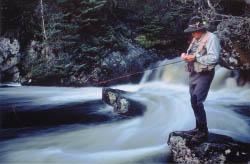The Absolute Beginner
Streamcraft Part Two: Reading The Water

By Piscator
In the last issue, I dealt with the art of being sneaky-the
art of approaching fish and getting into position to present
the fly without the fish detecting you. In this issue, we'll
take a look at how to find the fish-an art which is also known
as reading the water. As in
Part One in the last issue, the focus here is on resident
trout in streams, although the general principles apply to
some other species, such as smallmouth bass in rivers.
Casing the Joint
Just as with making the approach and presenting the fly,
reading the water also involves being sneaky. It's always hard
to resist the urge to rush down to the water as soon as you
arrive-especially if it's a location which has a lot of
fishing pressure and you have to scramble for the good spots.
However, it's always best if you hang back and take in the
general view of the river before you get your waders wet.
Check the water condition first. This can have a tremendous
effect on fish activity. For instance, high, turbid water in
spring and fall can put the fish down, while a freshet in the
dog days of summer can have just the opposite effect. If you're
on a familiar stream, it's easy to determine water level and flow
from past experience. On an unfamiliar stream ,check for dried-out
watermarks on rocks or on gravel banks as signs of a diminished
flow, and for submerged watermarks or littoral vegetation as signs
of high flow.
Next, check for hatch activity and for rising fish. The usual
places for these are close to the heads and tails of pools and
in runs close to cover, but it pays to scan as much of the water
as possible. For obvious reasons, this is much easier on a small
stream than on a big river.
If there are no rising fish, check for bird activity. Birds,
especially kingbirds and waxwings here in the east, frequently
anticipate hatches of flies, fluttering about in streamside
shrubs and trees. You'll also often see them feeding on spinners
high above the stream long before the spinners descend to the water.
Rising Fish
If you find a hatch on with fish rising to it, you don't
really have to look any further. You've located the fish.
What's important at this point is to identify what fly or
flies are hatching and how the fish are taking them, so that
you can match your artificial appropriately. Here's when you
shift into your stealth mode for your approach and presentation
(see this column in
The Canadian Fly Fisher, Fall/Winter 2001).
No Rising Fish
Years ago, in some of the snootier fly fishing clubs across
the Atlantic, the rules dictated that you could cast only to
rising fish. Fishing the water, that is, casting to likely
looking lies where you thought an unseen fish might be coaxed
into rising to your fly, was fiercely frowned upon. Even today,
you'll find vestiges of it.
But those old codgers just didn't know what they were missing,
for fishing the water successfully has its own unique delights
and presents the fly fisher with a whole new set of challenges
which take no less skill than casting to rising fish.
The primary skill necessary for successfully fishing the water
is to learn where the fish are most likely to be. Simply chucking
out your fly to cover every bit of water is an unnecessary waste
of energy-moreover, it can result in putting down fish-fish which
you might otherwise have caught, had you determined where they
were and made your approach and presentation specifically to them.
Finding the Fish
Trout have definite preferences in where they locate in a
stream. These places frequently differ from when they're
feeding on the surface, when they're feeding beneath the
surface, and when they're not feeding at all. The following
apply mainly to streams and smaller rivers; for while they
generally also apply to larger rivers, these tend to have
their own unique rules-especially in long, deep pools.

Trout, when they're not rising, like to hold in places where
they feel comfortable and safe and have to expend the minimum
amount of energy. For comfort, they prefer a well-oxygenated
flow over clean gravel which is sheltered from the full force
of the current. For safety, they seek places where there is
cover to one side and above. This can be provided by in-stream
structures, by depth of water, or by surface turbulence. Locations
close to major food production areas, such as riffles, are
favoured.
Optimum lies can be found in and just below riffles alongside
rocks, logs and branches, especially if there is a deeper pocket
of water. Similarly, you'll find them just downstream of riffles
as they deepen into pools. Undercut banks and overhanging bankside
vegetation alongside runs are also prime locations, as are deeper
pockets alongside and downstream from rocks in riffles. Concentrate
on these, and you'll have the best chance of raising trout when
they're not rising.
In the coming issues, we'll cover specific techniques of using the sneaky approach to present both floating and sinking flies to these hotspots. ~ Piscator
We thank the
Canadian Fly Fisher for re-print permission!
Our Man In Canada Archives
|

